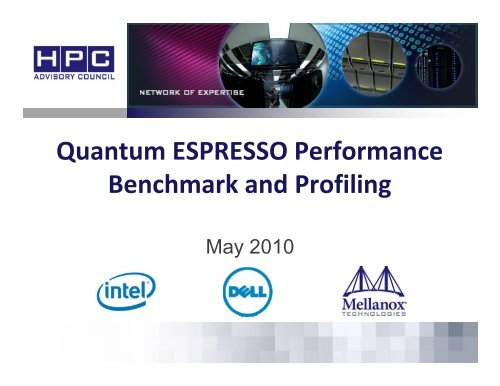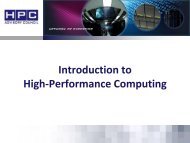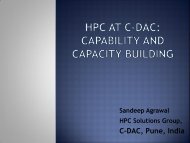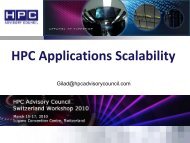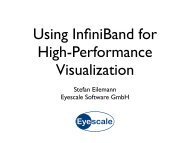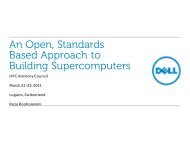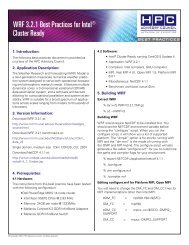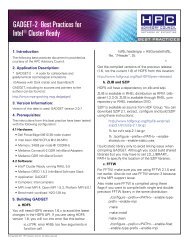Quantum ESPRESSO Benchmark Profiling - HPC Advisory Council
Quantum ESPRESSO Benchmark Profiling - HPC Advisory Council
Quantum ESPRESSO Benchmark Profiling - HPC Advisory Council
You also want an ePaper? Increase the reach of your titles
YUMPU automatically turns print PDFs into web optimized ePapers that Google loves.
<strong>Quantum</strong> <strong>ESPRESSO</strong> Performance<br />
<strong>Benchmark</strong> and <strong>Profiling</strong><br />
May 2010
Note<br />
• The following research was performed under the <strong>HPC</strong><br />
<strong>Advisory</strong> <strong>Council</strong> activities<br />
– Participating vendors: Intel, Dell, Mellanox<br />
– Compute resource - <strong>HPC</strong> <strong>Advisory</strong> <strong>Council</strong> Cluster Center<br />
• For more info please refer to<br />
– www.mellanox.com, ll www.dell.com/hpc, d ll /h www.intel.com, i t l<br />
http://www.quantum-espresso.org<br />
2
<strong>Quantum</strong> <strong>ESPRESSO</strong><br />
• <strong>Quantum</strong> <strong>ESPRESSO</strong> stands for opEn Source Package for Research<br />
in Electronic Structure, Simulation, and Optimization<br />
• It is an integrated suite of computer codes for electronic-structure<br />
calculations and materials modeling at the nanoscale<br />
• It is based on<br />
– Density-functional theory<br />
– Plane waves<br />
– Pseudopotentials (both norm-conserving and ultrasoft)<br />
• Open source under the terms of the GNU General Public License<br />
3
Objectives<br />
• The presented research was done to provide best practices<br />
– <strong>Quantum</strong> <strong>ESPRESSO</strong> performance benchmarking<br />
• MPI Library performance comparisons<br />
• Interconnect performance comparisons<br />
– Understanding <strong>Quantum</strong> <strong>ESPRESSO</strong> communication patterns<br />
– Power Power-efficient efficient simulations<br />
• The presented results will demonstrate<br />
– Th The scalability l bilit of f the th compute t environment i t to t provide id good d application li ti<br />
scalability<br />
– Considerations for power saving through balanced system configuration<br />
4
Test Cluster Configuration<br />
• Dell PowerEdge M610 16-node cluster<br />
• Quad-Core Intel X5570 @ 2.93 GHz CPUs<br />
• Intel Cluster Ready certified cluster<br />
• Mellanox ConnectX2 QDR InfiniBand mezzanine card<br />
• Mellanox M3601Q Q 32-Port Quad Q Data Rate (QDR-40Gb) (Q ) InfiniBand Switch<br />
• Memory: 24GB memory per node<br />
• OS: RHEL5U3, OFED 1.5 InfiniBand SW stack<br />
• File system: Lustre 1.8.2<br />
• MPI: Open MPI 1.3.3, MVAPICH2-1.4, Intel MPI 4.0<br />
• Application: <strong>Quantum</strong> <strong>ESPRESSO</strong> 4.1.2<br />
• <strong>Benchmark</strong> Workload<br />
– Medium size DEISA benchmark AUSURF112<br />
• Gold surface (112 atoms)<br />
5
Mellanox InfiniBand Solutions<br />
• Industry Standard<br />
– Hardware, software, cabling, management<br />
– Design g for clustering g and storage g interconnect<br />
• Performance<br />
– 40Gb/s node-to-node<br />
– 120Gb/s switch-to-switch<br />
– 11us application li i llatency<br />
– Most aggressive roadmap in the industry<br />
• Reliable with congestion management<br />
• Efficient<br />
– RDMA and Transport Offload<br />
– Kernel bypass<br />
– CPU focuses on application processing<br />
• SScalable l bl for f Petascale P t l computing ti & beyond b d<br />
• End-to-end quality of service<br />
• Virtualization acceleration<br />
• I/O consolidation lid ti Including I l di storage t<br />
The InfiniBand Performance<br />
Gap is Increasing<br />
60Gb/s<br />
20Gb/s<br />
120Gb/s<br />
40Gb/s<br />
240Gb/s<br />
(12X)<br />
80Gb/s<br />
(4X)<br />
Ethernet<br />
Fibre<br />
Channel<br />
InfiniBand Delivers the Lowest Latency<br />
6
Delivering Intelligent Performance<br />
Next Generation Intel ® Microarchitecture<br />
Bandwidth Intensive<br />
• Intel ® • Intel QuickPath Technology<br />
® QuickPath Technology<br />
• Integrated Memory Controller<br />
Intel Threaded Applications<br />
® 5520 Intel ® Intel Data Center<br />
Threaded Applications<br />
Chipset<br />
Intel ® Node Manager<br />
Technology<br />
Intel ® X25-E<br />
SSDs<br />
PCI Express* 2.0<br />
ICH 9/10<br />
Manager<br />
• 45nm quad-core Intel ® Xeon ® Processors<br />
• Intel ® Hyper-threading Technology<br />
Performance on Demand<br />
• Intel ® Turbo Boost Technology<br />
• Intel ® Intelligent Power Technology<br />
Performance That Adapts p<br />
to The Software Environment<br />
7
Intel ® Cluster Ready<br />
• Intel® Cluster Ready is a consistent reference Linux platform architecture<br />
for Intel-based systems<br />
– Makes it easier to design, g , develop, p, and build applications pp for clusters<br />
• A single architecture platform supported and used by a wide range of<br />
OEMs, ISVs, cluster provisioning vendors, and interconnect providers<br />
• Includes<br />
– Platform specification, that defines the Intel Cluster Ready platforms<br />
– Program branding, that makes it easier to identify compliant solutions and<br />
applications<br />
– Hardware certifications, confirming solutions that are delivered ready to run<br />
– Application registration registration, validating applications that execute on top of Intel Cluster<br />
Ready architecture<br />
– Intel® Cluster Checker tool, to validate hardware and software configuration and<br />
functionality<br />
8
Dell PowerEdge Servers helping Simplify IT<br />
• System Structure and Sizing Guidelines<br />
– 16-node cluster build with Dell PowerEdge M610 blades server<br />
– SServers optimized ti i d ffor Hi High h PPerformance f CComputing ti environments i t<br />
– Building Block Foundations for best price/performance and performance/watt<br />
• Dell <strong>HPC</strong> Solutions<br />
– Scalable Architectures for High Performance and Productivity<br />
– Dell's comprehensive <strong>HPC</strong> services help manage the lifecycle requirements.<br />
– Integrated, Tested and Validated Architectures<br />
• Workload Modeling<br />
– Optimized p System y Size, , Configuration g and Workloads<br />
– Test-bed <strong>Benchmark</strong>s<br />
– ISV Applications Characterization<br />
– Best Practices & Usage Analysis<br />
9
Lustre File System Configuration<br />
• Lustre Configuration<br />
– 1 MDS<br />
– 4 OSS (Each has 2 OST)<br />
– InfiniBand based<br />
Backend storage<br />
– All components are<br />
connected through<br />
InfiniBand QDR<br />
interconnect<br />
Lustre<br />
MDS/OSS OSS OSS OSS<br />
IB QDR Switch<br />
Cluster<br />
Nodes<br />
IB QDR Switch<br />
St Storage<br />
10
<strong>Quantum</strong> <strong>ESPRESSO</strong> <strong>Benchmark</strong> Results - File System<br />
• Intel MPI has native Lustre support<br />
– mpiexec -genv I_MPI_EXTRA_FILESYSTEM on -genv I_MPI_EXTRA_FILESYSTEM_LIST lustre<br />
• Lustre enables higher performance<br />
– Up to 13% faster than local hard disk at 16 nodes<br />
Higher is better<br />
13%<br />
8-cores per node<br />
11
<strong>Quantum</strong> <strong>ESPRESSO</strong> <strong>Benchmark</strong> Results<br />
• Customized MPI parameters provide better performance<br />
– Up to 22% higher performance with Open MPI<br />
• --mca mpi_affinity_alone 1 --mca coll_tuned_use_dynamic_rules 1 --mca coll_tuned_alltoallv_algorithm 2 --mca<br />
coll_tuned_allreduce_algorithm 0 --mca coll_tuned_barrier_algorithm 6<br />
Higher is better<br />
22%<br />
8-cores per node<br />
12
<strong>Quantum</strong> <strong>ESPRESSO</strong> <strong>Benchmark</strong> Results<br />
• Intel MPI enables higher performance<br />
– Up to 2% higher performance than MVAPICH2 and 12% than Open MPI<br />
Higher is better<br />
8-cores per node<br />
13
<strong>Quantum</strong> <strong>ESPRESSO</strong> <strong>Benchmark</strong> Results<br />
• Multi-thread Intel MPI doesn’t provide higher performance<br />
– Up to 32% slower than non-threaded application performance<br />
Higher is better<br />
32%<br />
8-cores per node<br />
14
<strong>Quantum</strong> <strong>ESPRESSO</strong> <strong>Benchmark</strong> Results<br />
• InfiniBand enables better application performance and scalability<br />
– Up to 261% higher performance than GigE<br />
– GigE stops scaling after 8 nodes<br />
• Application performance over InfiniBand scales as cluster size increases<br />
Higher is better<br />
261%<br />
8-cores per node<br />
15
Power Cost Savings with Different Interconnect<br />
• InfiniBand saves up to $8890 power compared to GigE<br />
– To finish the same number of <strong>Quantum</strong> <strong>ESPRESSO</strong> jobs<br />
– Yearly based for 16-node 16 node cluster<br />
• As cluster size increases, more power can be saved<br />
$8890<br />
$/KWh = KWh * $0.20<br />
For more information - http://enterprise.amd.com/Downloads/svrpwrusecompletefinal.pdf<br />
16
<strong>Quantum</strong> <strong>ESPRESSO</strong> <strong>Benchmark</strong> Results Summary<br />
• Balanced system – CPU, memory, Interconnect that match each<br />
other capabilities - is essential for providing application efficiency<br />
• Performance Optimization<br />
– MPI libraries showed comparable performance overall<br />
• Intel MPI enables slightly higher performance<br />
– Lustre with IB delivers increased performance<br />
– Enabling multi-thread does not yield performance increase<br />
• Interconnect Characterization<br />
– InfiniBand continues to deliver superior performance across a broad<br />
range of system sizes<br />
– GigE scalability is limited beyond 8 nodes<br />
• PPower Analysis A l i<br />
– System architecture can yield nearly $9K annually in power savings<br />
17
<strong>Quantum</strong> <strong>ESPRESSO</strong> <strong>Profiling</strong> – Runtime Distribution<br />
• Percentage of communication time increases as cluster size scales<br />
– 5% at 32 processes, increases up to 50% at 128 processes<br />
18
<strong>Quantum</strong> <strong>ESPRESSO</strong> <strong>Profiling</strong> - % of MPI Time<br />
• Three MPI collectives (MPI_Barrier, MPI_allreduce, and MPI_Alltoallv)<br />
consume more than 80% of total MPI time<br />
32p 64p<br />
128p<br />
19
<strong>Quantum</strong> <strong>ESPRESSO</strong> <strong>Profiling</strong> - Message Size<br />
• Both small and large messages are creating communication overhead<br />
– Most messages called by Barrier and Allreduce are small messages (128KB) )<br />
Allreduce Alltoallv<br />
128 processes<br />
20
<strong>Quantum</strong> <strong>ESPRESSO</strong> <strong>Profiling</strong> Summary<br />
• <strong>Quantum</strong> <strong>ESPRESSO</strong> was profiled to identify its communication patterns<br />
• Time in communication increases faster relative to computation p<br />
• MPI Collective functions dominate total MPI communication time<br />
– More than 90% MPI time is spent in MPI collectives<br />
– Total number of messages increases with cluster size<br />
• Interconnects effect to <strong>Quantum</strong> <strong>ESPRESSO</strong> performance<br />
– Both small and large messages are used by <strong>Quantum</strong> <strong>ESPRESSO</strong><br />
– Interconnect latency and bandwidth are critical to application performance<br />
• Balanced system – CPU CPU, memory memory, Interconnect that match each other<br />
capabilities, is essential for providing application efficiency<br />
21
Productive Systems = Balanced System<br />
• Balanced system enables highest productivity<br />
– Interconnect performance to match CPU capabilities<br />
– CPU capabilities to drive the interconnect capability<br />
– Memory bandwidth to match CPU performance<br />
• Applications scalability relies on balanced configuration<br />
– “Bottleneck free”<br />
– Each system components can reach it’s highest capability<br />
• Dell M610 system integrates balanced components<br />
– Intel “Nehalem” CPUs and Mellanox InfiniBand QDR<br />
• Latency to memory and Interconnect latency at the same magnitude of order<br />
– Provide the leading productivity and power/performance system for<br />
Desmond simulations<br />
22
23<br />
Thank You<br />
<strong>HPC</strong> Ad <strong>Advisory</strong> i <strong>Council</strong> C il<br />
All trademarks are property of their respective owners. All information is provided “As-Is” without any kind of warranty. The <strong>HPC</strong> <strong>Advisory</strong> <strong>Council</strong> makes no representation to the accuracy and<br />
completeness of the information contained herein. <strong>HPC</strong> <strong>Advisory</strong> <strong>Council</strong> Mellanox undertakes no duty and assumes no obligation to update or correct any information presented herein<br />
23


